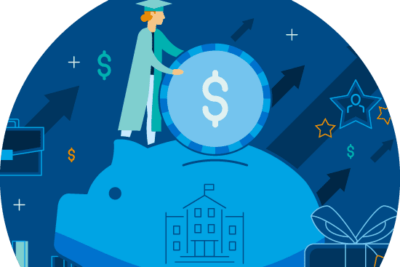Why do fiscally conscientious students default on their loans?
Poor financial management is not the problem
Imagine that someone borrows thousands of dollars in federal loans. Now imagine this person cannot repay and defaults on those loans, rocking their own financial stability and costing taxpayers money each year. Do the words “careful,” “cautious,” or “conscientious” come to mind when you think of this person? Probably not—but you may be wrong.
In 2015, the student loan company Sallie Mae released a study concluding that American college students have a “careful approach” to managing money and “cautious attitude” towards debt. The survey of about 800 college students included community college enrollees.
Internet commentators put the question the most clearly, if bluntly: If college students are so conscientious, then how do they end up with thousands of dollars in debt that they cannot repay?
It’s true that among all students entering into the repayment phase in 2012 (typically 6 months after leaving the institution), 11.8% defaulted on their loans within three years. For public two-year institutions, that figure is 19.1%, the highest 3-year cohort default rate of any institution type.
Student default is important for college leaders to track, understand, and manage. As part of the reauthorization of the Higher Education Act, legislators are tracking institutional cohort default rates (CDRs) more closely. Colleges with CDRs above 30% for three consecutive years may face discontinuation of federal financial aid for their students and a decline in public opinion.
But high CDRs don’t conflict with or disprove the results of the Sallie Mae study. They do, however, point to a great failing of federally mandated student loan counseling and how we prepare (or don’t prepare) students for loan repayment.
Community college defaulters don’t stick around long enough for exit counseling
The Department of Education requires colleges and universities to provide loan counseling to federal borrowers twice: at the point of entering the institution and again around graduation.
But many students leave the college before graduation, and miss out on that second instance of loan counseling.
The Association of Community College Trustees’ 2015 study of student borrowing and repayment trends found that most defaulters (nearly 90%) left the college before earning a certificate or degree. When a student leaves unexpectedly he misses out on exit loan counseling, but is still responsible for repaying loans.
This means community colleges effectively have one shot to teach students about the responsibility of accepting and repaying loans: during entrance loan counseling at onboarding.
Loan counseling modules feel too generic, technical, and long
Despite students’ interest in learning more about loan management and ensuring their own financial stability, observations and interviews with student borrowers reveal a standard loan counseling process that is confusing and unsurprisingly leads to widespread student disengagement.
In the spectrum of “fight or flight” student onboarding reactions, the most common reaction to student loan counseling is ‘flight.’ Students may literally leave the institution and drop out from the enrollment process, but more likely they withdraw by passively clicking through modules without absorbing any information.
Read more about student feedback on onboarding steps
Shortly after leaving the institution, students must deal with the consequences of this early disengagement as they confront their first loan payment deadline.
Build a loan counseling program around students
Even the most boring tasks—like learning about loan repayments—can become engaging with personalization. In the private sector, new consumer technologies have turned chores like balancing budgets and booking travel into fun, easy, and informative activities.
Looking to start your own loan counseling modules?
In developing SSC-Navigate, we’ve seen just how effectively technology can transform a generic onboarding process into a personalized experience for students to complete enrollment tasks and receive customized guidance about academic programs, courses, and scheduling.
Face-to-face loan counseling can also be effective with a facilitator who draws a clear connection between loans, repayment, and students’ futures. At one EAB member college, all students who plan to accept public or private loans to pay for college are strongly encouraged to attend a debt management workshop that has contributed to a 3-percentage point decline in the college’s CDR since implementation.
The key to success? Contacts at the college highlight anecdotes and personal stories to explain to students the potential impact debt can have on their present and future lives. Few things inspire more student attention and engagement than a discussion of their future careers, dreams of home ownership, and romantic relationships.
More Blogs

The impact of the delayed FAFSA rollout on college retention

3 ways technology can help overcome financial barriers
